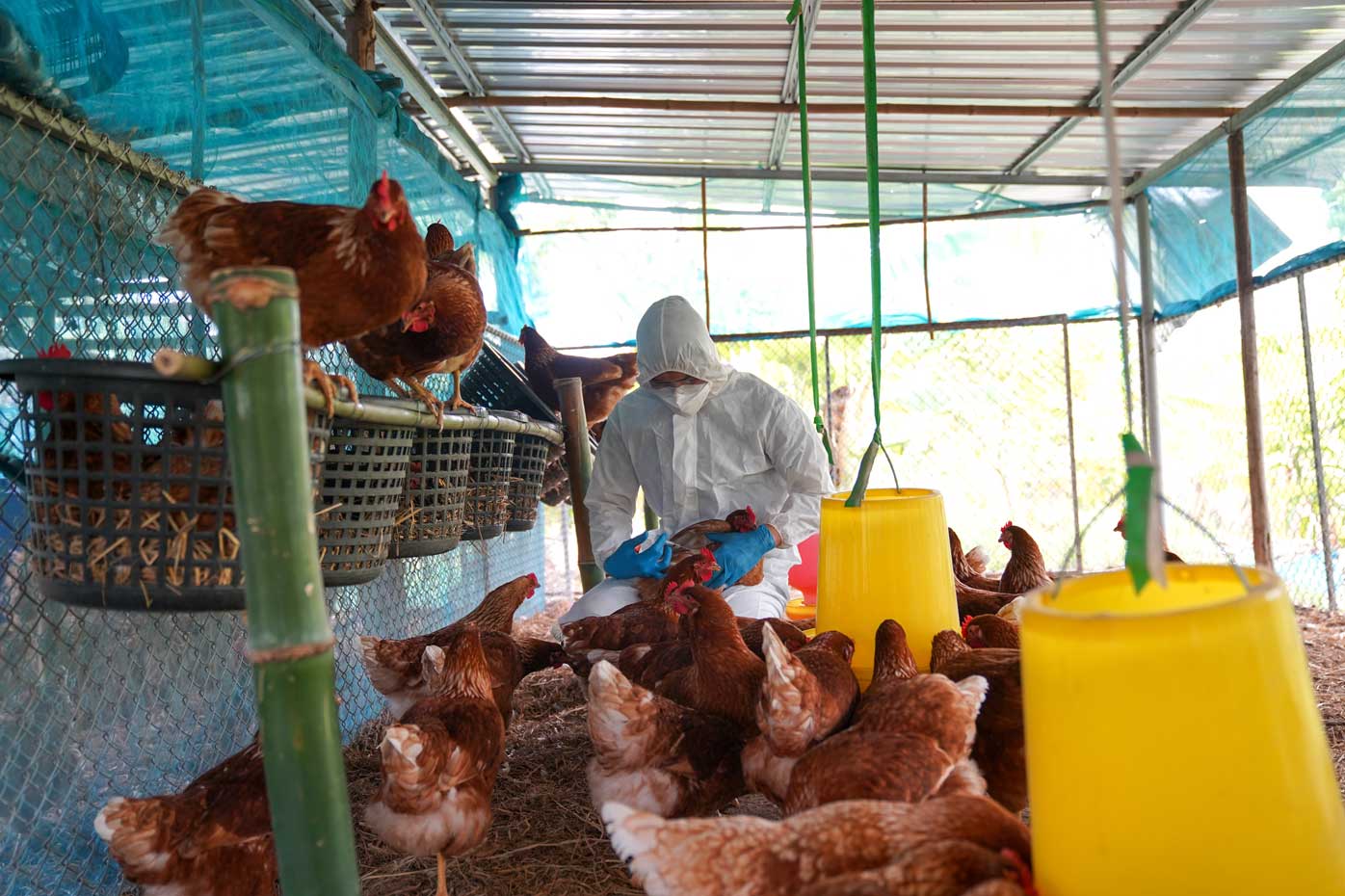Symptoms and Treatments
Human disease can occur after contact with infected bird droppings, saliva, or contaminated food and water; hence poultry workers are at higher risk of infection than the general population. The onset of symptoms after initial infection usually appears after three to five days. For H5N1 infection, human incubation is between two and five days but can be as long as 17 days.3 Symptoms of avian influenza include headache, sore muscles, cough or shortness of breath, and an extremely high temperature. Other symptoms may include diarrhea, nausea, chest pain, conjunctivitis, and nasal hemorrhage.7 In severe cases, it can lead to encephalitis, pneumonia, multi-organ failure, and acute respiratory distress syndrome (ARDS), as the lungs of those infected experience diffuse alveolar destruction and bleeding. High viral loads, lymphopenia, and elevated levels of cytokines have all been associated with fatal outcomes in H5N1-infected individuals.3
Treatments include antiviral medication such as Tamiflu (oseltamivir), Rabivab (peramivir), and Relenza (zanamivir), which are aimed at reducing the severity of symptoms, preventing complications, and improving the chances of survival. All drugs are NA inhibitors and are most effective when taken early in infections. However, the best defense against the influenza virus remains vaccination.7
History of human avian influenza infection
In 1918, the subtype H1N1 caused the Spanish Flu pandemic, resulting in millions of deaths worldwide. This was followed by the Asian Flu pandemic in 1957 (H2N2), the China Flu pandemic in 1968 (H3N2), and the H1N1 ‘swine flu’ global pandemic in 2009.3 H5N1 is currently the most problematic strain of the flu virus. First identified in 1959, it remained undetected until 1996 when the virus was found in geese in southern China and Hong Kong. In 1997, 18 people became infected with H5N1 resulting in six deaths; the virus did not reemerge again in humans until 2003.9 The highly pathogenic strain H7N9 was first identified in humans in China in 2013, and the country experienced several waves of infection up to 2017. Cases identified outside of China were found to be in people who had traveled from the country.4
Infection and mortality rates
During the severe pandemic of 1918, over 500 million people (about one-third of the world’s population at the time) became infected with H1N1, and between fifty to hundred million people were reported to have died. The 1968 H3N2 pandemic was reported to have killed 0.03% of the world’s population, but by the 2009 H1N1 pandemic, just 0.001% to 0.007% of the global population died during the first 12 months. Still, this accounted for an estimated 700 million to 1.4 billion human infections and 151,700 – 575,400 deaths, a mortality rate between 0.02% and 0.04%.3, 10
AIV subtypes H5N1 and H7N9 are of most concern as they can cause severe symptoms in humans, leading to a high mortality rate. Globally, as of 2 June 2023, there have been 876 human infections with H5N1, including 458 deaths reported in 23 countries since 2004, a mortality rate of 52.2%, while H7N9 has caused 1,567 human infections and 615 deaths, a mortality rate of 39%. 4, 6
Figure 1: Distribution of confirmed human cases of H5N1 infection by year of onset and country (2003-2023)6
Source: ECDC
*Note: Includes two detections reported in 2022 from Spain and one from the United States due to suspected environmental contamination and no evidence of infection
H5N6 has been reported in China and Laos, causing 84 human infections and 29 subsequent deaths, a mortality rate of 35%.1 H9N2, first identified in humans in 1998, is a low pathogenic AIV and therefore differs in virulence from H5N1 and H7N9. As it is not a notifiable infection, only 124 human infections and one death have been recorded.6
Since the 2009 "swine flu" pandemic, the influenza A H1N1 virus circulates seasonally, causing multiple infections, hospitalizations, and deaths. The CDC estimates that in the U.S., from 2009 to 2018 there were over 100 million infections, of which fewer than 1% of individuals were hospitalized. There were a reported 75,000 deaths, a mortality rate of 0.075%. 11
Vaccines
One of the ways to combat a pandemic is through mass population immunity. Immunity can occur either through natural infection or vaccination. Creating vaccines is a long and arduous process, but as there are already approved influenza vaccines, adapting them to new strains typically only takes around 6 months.4
The development of messenger ribonucleic acid (mRNA) vaccines is not new, but they came to the forefront during the COVID-19 pandemic when they were rapidly approved in response to the SARS-CoV-2 viral outbreak in humans. mRNA vaccines have many advantages, particularly as part of a pandemic response, as they can be manufactured quickly and are highly scalable.
In 2016, The European Medicines Agency (EMA) granted conditional marketing approval for the pandemic influenza vaccine H5N1 AstraZeneca, meaning that it was approved in the interests of public health based on less comprehensive data than normally required, as the medicine addressed an unmet medical need.12 The US Food and Drug Administration (FDA) has also licensed the use of two H5N1 influenza virus vaccines.13





